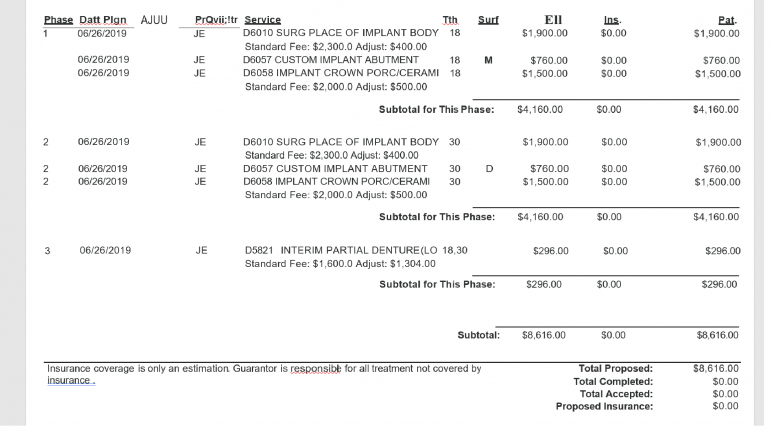
Dental Code D7287: Exfoliative cytological sample collection
Dental Code D7287, also known as exfoliative cytological sample collection, is a diagnostic procedure used in dentistry to gather cellular samples from oral tissues for analysis. This code specifically refers to the collection of exfoliated cells from the oral cavity, which can provide valuable insights into potential oral health concerns.
Dental Code D7287 Price Range
On average, patients pay $188 for this D7287 service at the dentist's office, with as little as $114 charged for this in less expensive cities and as much as $311 in more expensive cities.
Low cost of living | Medium cost of living | High cost of living |
Memphis (Tennessee), Cincinnati (Ohio) | Miami (Florida), Denver (Colorado), Austin (Texas) | (New York (New York), San Francisco (California) |
$114 | $188 | $311 |
However, the price for the service D7287 depends not only on the region where you live, but also varies from dentist to dentist. Therefore, it makes sense to compare prices before choosing a dentist. The best way to do this price comparison is at Dr. BestPrice and save a lot of money.
Detailed Information about the Procedure and Steps
Dental Code D7287 refers to a specific diagnostic procedure in dentistry that involves the collection of exfoliated cells from the oral cavity for cytological analysis. This code is used to identify and investigate any abnormal cellular changes that may be indicative of oral health conditions, including precancerous or cancerous lesions.
Exfoliative cytological sample collection is a non-invasive procedure that allows dentists to gather cellular samples from the surface of oral tissues. The collected cells are then examined under a microscope by trained laboratory professionals or pathologists to detect any abnormal cellular patterns or structures.
The procedure consists of several steps, including patient preparation, oral tissue examination, collection of exfoliated cells using specialized brushes or spatulas, fixation and staining of the collected cells, and microscopic examination. These steps are carried out to ensure accurate analysis and identification of any potential oral health concerns.
Patient Preparation
Before the exfoliative cytological sample collection procedure, the dentist will ensure that the patient is properly prepared. This may involve instructing the patient to refrain from eating or drinking for a certain period before the appointment. Additionally, the dentist will review the patient's medical history and address any concerns or questions related to the procedure.
Oral Tissue Examination
The dentist will conduct a thorough examination of the oral tissues to identify any areas of concern. This examination may involve visual inspection, palpation, and the use of specialized tools such as a dental mirror and probe. The purpose is to identify areas that require further investigation through exfoliative cytological sample collection. During the exfoliative cytological sample collection procedure, the dentist begins by conducting a comprehensive examination of the oral tissues to identify any areas that may require further investigation. This examination is crucial in determining the specific regions where the exfoliated cell collection will be performed.
The dentist employs various techniques to thoroughly examine the oral tissues. Visual inspection is one such method, wherein the dentist visually examines the oral cavity using a dental mirror. This allows for a detailed assessment of the teeth, gums, tongue, and other oral structures. The dentist looks for any visible abnormalities such as discolored patches, ulcers, or unusual growths that might indicate a potential oral health concern.
Collection of Exfoliated Cells
Once the areas of interest are identified, the dentist will proceed with the collection of exfoliated cells. This is typically done using a specialized brush or spatula. The dentist will gently scrape or brush the targeted area, collecting a sample of cells onto the instrument. The process is painless and non-invasive, as it involves only the outermost layer of cells.
Fixation and Staining
After the collection, the exfoliated cells are transferred to a slide or a container for fixation and staining. Fixation helps preserve the cellular structure and prevents degradation, ensuring accurate analysis. Staining is performed to enhance the visibility of cellular details under a microscope, enabling easier identification and analysis of abnormal cells.
Microscopic Examination
Once the cells have been fixed and stained, they are examined under a microscope by a trained laboratory professional or a pathologist. This examination allows for the identification of any abnormal cellular changes, such as precancerous or cancerous cells. The results of this analysis provide valuable information for the dentist in diagnosing potential oral health conditions. Following the fixation and staining of the collected exfoliated cells, the next crucial step in the exfoliative cytological sample collection procedure is the microscopic examination. The fixed and stained cells are carefully placed onto slides or containers, which are then handed over to a trained laboratory professional or a pathologist for analysis.
Summary of Dental Code D7287
Dental Code D7287, exfoliative cytological sample collection, is a diagnostic procedure that involves gathering cellular samples from the oral cavity for analysis. The steps of the procedure include patient preparation, oral tissue examination, collection of exfoliated cells, fixation and staining, and microscopic examination. By analyzing these exfoliated cells, dentists can detect and diagnose potential oral health concerns, including precancerous and cancerous conditions. This code plays a crucial role in improving early detection and treatment outcomes for patients, highlighting the importance of regular dental check-ups and screenings.
In conclusion, dental code D7287 serves as a valuable tool in dental diagnostics, allowing dentists to gather essential information about a patient's oral health through the collection and analysis of exfoliated cells. By understanding the procedure and its steps, patients can appreciate the significance of this code in promoting early detection and effective treatment of oral health conditions. Regular dental visits that include exfoliative cytological sample collection can contribute to maintaining optimal oral health and overall well-being.
Make waves in the world of dental affordability with Dr. BestPrice! Your budget-friendly smile awaits.
